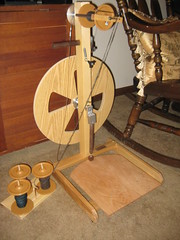


I've begun doing my alpaca handling homework. I purchased a CD-rom on alpaca body language by Cathy Spaulding, a noted alpaca handler. I've also been reading
Camelid Companion, by Marty McGee-Bennett. She is regarded as the most skilled handler and trainer in the alpaca industry. An 'alpaca whisperer', if you will. Her stance on handling and training is that we need to help our animals understand that they can override their flight instincts by giving them enough space to move away from us if they need to. Alpacas can learn that humans are safe if we handle them with a calm, respectful energy. We must let them know that we understand their need to get away from us and we will accommodate that to some degree.
I went to visit my animal yesterday with the intention of working on two things: moving around the catch pen in an organized fashion, and standing in balance. These two things both lend themselves to helping the animal realize that it will allowed to move away from the human if needed, but only within the confines of the catch pen. I put Devi and two of her buddies (about the same age as her, all around six months old) into the catch pen. I was equipped with herding wands and catch rope (a la Ms. McGee-Bennett). I first worked on moving them in a mini 'herd' around the catch pen, causing change of direction only when I wanted them to by changing my position within the catch pen in relation to the animals. My attention was focused on Devi, since I was there to work with her. The other two little girls are just there to provide her some company so she can calm down more easily. The goal is to show the animal that I will allow her an escape route - a way to move a way from me - when she needs it, and to give her a chance to settle down. Also, moving the animals around the catch pen in an organized fashion allows them to see that the handler has a plan. Randomness produces more anxiety. A handler must show she is a leader.
I think I started out very well. The girls moved around the catch pen in the direction I wanted. I made this happen by placing my body at what Marty calls point one, or the walking point, in relation to the alpaca's body. This is back behind the animal's hip, outside of her flight zone. By placing myself more toward the middle of her body, but still behind her eye, I can get her to stop. By moving ahead of her I can cause a change of direction. Of course, this all sounds simple and Marty makes it look very easy, but in a catch pen with three six month old alpacas, real life does not necessarily follow the text book. There were several instances where, when I placed myself at the walking point, the animals didn't walk. Apparently they have not read the book yet. They were all humming for their mothers too, which created an interesting sounding little cria chorus, but prevented total focus.
Then I went for the catch rope. I've gotten it on the animal before, so that was no problem. Of course, clipping it in place when the animal is still walking is another story. "Hey! I'm at the stopping point. You're supposed to stop!" I did manage to clip the catch rope, but it wasn't properly placed high on the neck. Never the less, I got her to take a few steps in response to some re-balancing cues. That is a success for such a young animal.
Finally, I hoped to work with her head in my hands a bit so she could learn that having her head handled by humans doesn't mean danger, and so I could practice getting her to stand in balance. Easier said than done. She didn't want to stand, and my aim was to let her know that I understand her need to get away, so if she didn't want to stand we walked. Not exactly standing in balance.
All in all it was a successful experience. The animals were relaxed, even though they missed their mothers, and I improved my skills as a handler. I do need to keep in mind that when I read about handling and training, or watch a video, it's in reference to adult alpacas. Babies have a much shorter tolerance for the amount of time spent in 'school'. I kept these little girls in the catch pen for quite a while. They did very well.






















.jpg)